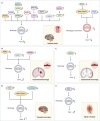Mitophagy in acute central nervous system injuries: regulatory mechanisms and therapeutic potentials
- PMID: 39248161
- PMCID: PMC11801284
- DOI: 10.4103/NRR.NRR-D-24-00432
Mitophagy in acute central nervous system injuries: regulatory mechanisms and therapeutic potentials
Abstract
Acute central nervous system injuries, including ischemic stroke, intracerebral hemorrhage, subarachnoid hemorrhage, traumatic brain injury, and spinal cord injury, are a major global health challenge. Identifying optimal therapies and improving the long-term neurological functions of patients with acute central nervous system injuries are urgent priorities. Mitochondria are susceptible to damage after acute central nervous system injury, and this leads to the release of toxic levels of reactive oxygen species, which induce cell death. Mitophagy, a selective form of autophagy, is crucial in eliminating redundant or damaged mitochondria during these events. Recent evidence has highlighted the significant role of mitophagy in acute central nervous system injuries. In this review, we provide a comprehensive overview of the process, classification, and related mechanisms of mitophagy. We also highlight the recent developments in research into the role of mitophagy in various acute central nervous system injuries and drug therapies that regulate mitophagy. In the final section of this review, we emphasize the potential for treating these disorders by focusing on mitophagy and suggest future research paths in this area.
Copyright © 2025 Copyright: © 2025 Neural Regeneration Research.
Conflict of interest statement
Figures





Similar articles
-
Mitophagy in intracerebral hemorrhage: a new target for therapeutic intervention.Neural Regen Res. 2024 Feb;19(2):316-323. doi: 10.4103/1673-5374.379019. Neural Regen Res. 2024. PMID: 37488884 Free PMC article. Review.
-
Crosstalk among mitophagy, pyroptosis, ferroptosis, and necroptosis in central nervous system injuries.Neural Regen Res. 2024 Aug 1;19(8):1660-1670. doi: 10.4103/1673-5374.389361. Epub 2023 Nov 8. Neural Regen Res. 2024. PMID: 38103229 Free PMC article.
-
Regulation of mitophagy in ischemic brain injury.Neurosci Bull. 2015 Aug;31(4):395-406. doi: 10.1007/s12264-015-1544-6. Epub 2015 Jul 28. Neurosci Bull. 2015. PMID: 26219224 Free PMC article. Review.
-
Mitophagy in Acute Kidney Injury and Kidney Repair.Cells. 2020 Feb 1;9(2):338. doi: 10.3390/cells9020338. Cells. 2020. PMID: 32024113 Free PMC article. Review.
-
Mitophagy in Cerebral Ischemia and Ischemia/Reperfusion Injury.Front Aging Neurosci. 2021 Jun 8;13:687246. doi: 10.3389/fnagi.2021.687246. eCollection 2021. Front Aging Neurosci. 2021. PMID: 34168551 Free PMC article. Review.
Cited by
-
A novel mitochondrial autophagy and aging-related gene signature for predicting ovarian cancer.Front Immunol. 2025 Jun 5;16:1594021. doi: 10.3389/fimmu.2025.1594021. eCollection 2025. Front Immunol. 2025. PMID: 40539060 Free PMC article.
-
LncRNA regulation in ischemic stroke and their application prospects.Neural Regen Res. 2026 Mar 1;21(3):1058-1073. doi: 10.4103/NRR.NRR-D-24-00924. Epub 2025 Mar 25. Neural Regen Res. 2026. PMID: 40145979 Free PMC article.
References
-
- Abbaszadeh F, Fakhri S, Khan H. Targeting apoptosis and autophagy following spinal cord injury: Therapeutic approaches to polyphenols and candidate phytochemicals. Pharmacol Res. 2020;160:105069. - PubMed
-
- Ajoolabady A, Wang S, Kroemer G, Penninger JM, Uversky VN, Pratico D, Henninger N, Reiter RJ, Bruno A, Joshipura K, Aslkhodapasandhokmabad H, Klionsky DJ, Ren J. Targeting autophagy in ischemic stroke: From molecular mechanisms to clinical therapeutics. Pharmacol Ther. 2021;225:107848. - PMC - PubMed
-
- Ambivero CT, Cilenti L, Main S, Zervos AS. Mulan E3 ubiquitin ligase interacts with multiple E2 conjugating enzymes and participates in mitophagy by recruiting GABARAP. Cell Signal. 2014;26:2921–2929. - PubMed
LinkOut - more resources
Full Text Sources

